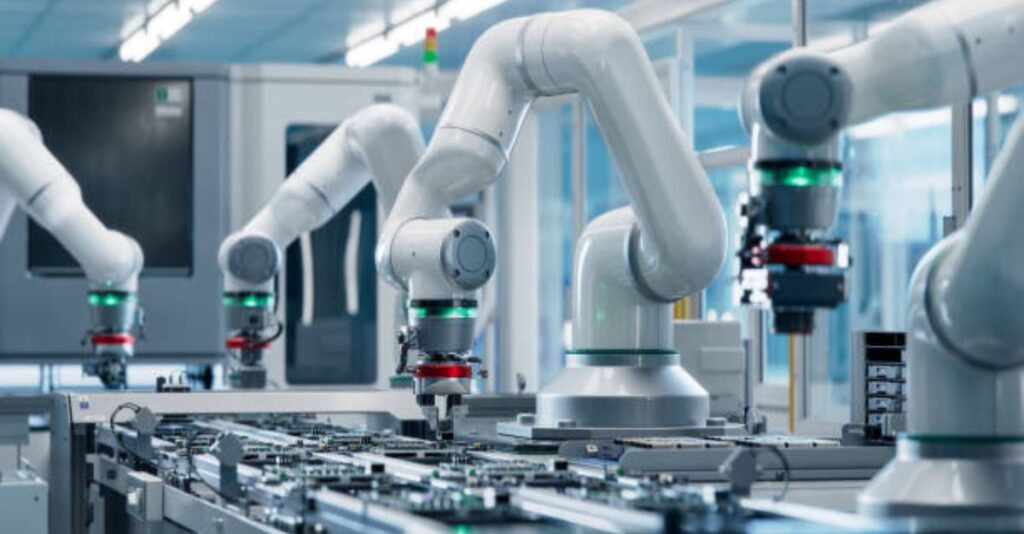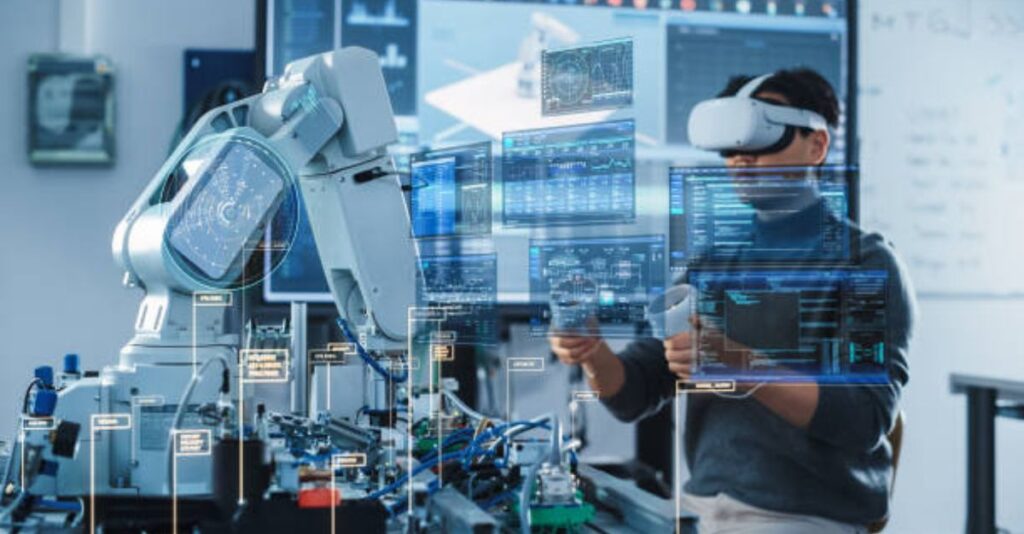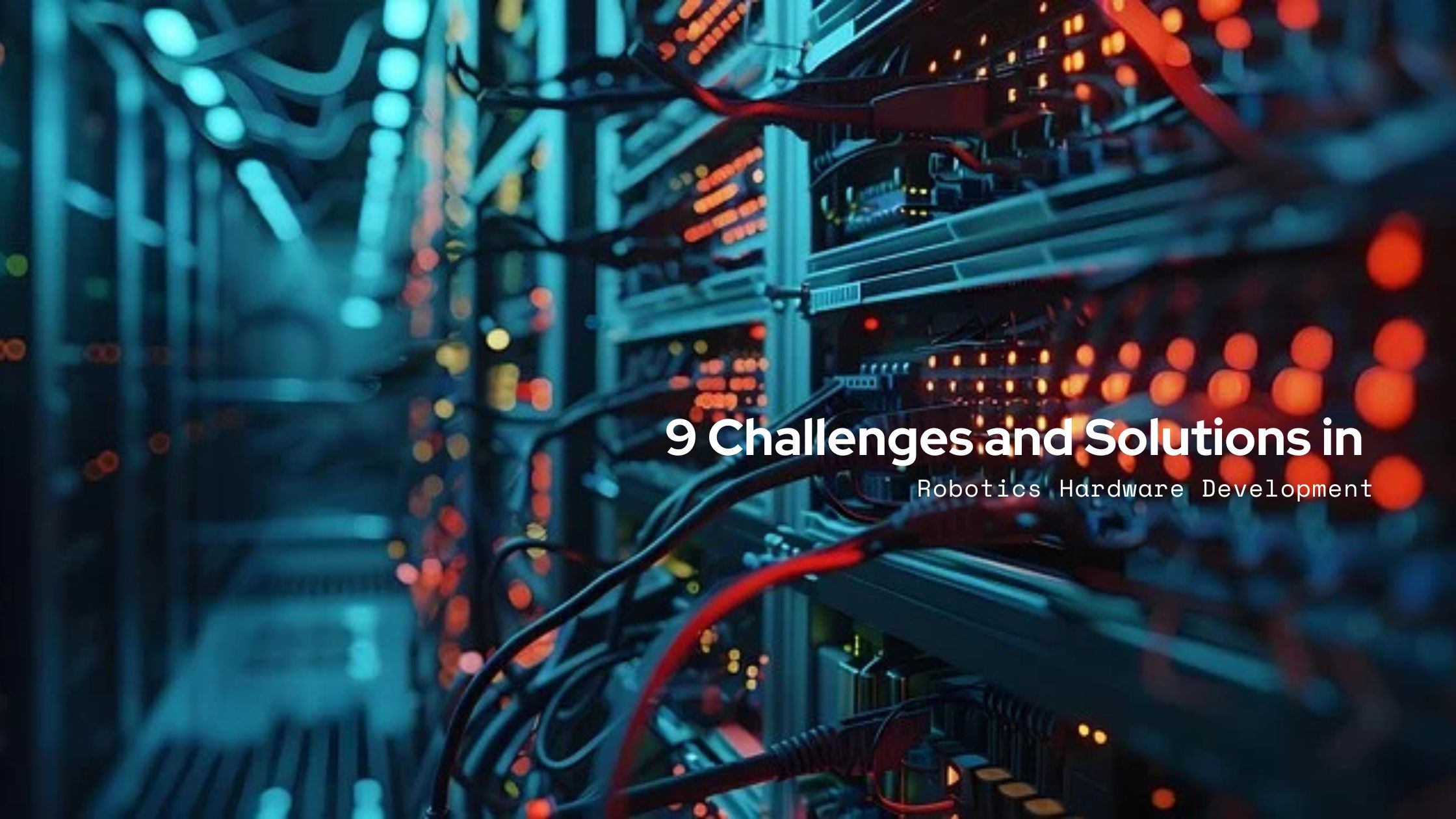Introduction
9 Challenges and Solutions in Robotics Hardware Development
Robotics hardware is at the core of technological advancements in artificial intelligence, automation, and Industry 4.0. However, developing robotics hardware presents several challenges that must be addressed for seamless integration and efficiency. This article explores nine major challenges in robotics hardware development and their practical solutions.
9 Challenges and Solutions in Robotics Hardware Development

1. High Development Costs
Challenge: Robotics hardware development requires substantial investment in research, materials, and testing, making it expensive for startups and small businesses.
Solution: Leveraging open-source hardware, collaborative research, and modular designs can help reduce costs. Government grants and crowdfunding are also viable funding options.
2. Limited Battery Life and Energy Efficiency
Challenge: Many robots require long operational hours, but battery technology struggles to keep up, leading to frequent recharges and reduced productivity.
Solution: Utilizing high-density lithium-ion and solid-state batteries, optimizing power management software, and integrating energy-efficient components can enhance battery performance.
3. Complex Sensor Integration
Challenge: Robots rely on multiple sensors (LiDAR, cameras, infrared, ultrasonic) for navigation and perception, but integrating these seamlessly can be difficult.
Solution: Using standardized sensor modules, AI-driven sensor fusion techniques, and calibration automation can streamline integration and enhance data accuracy.
4. Hardware Durability and Maintenance
Challenge: Robots often operate in harsh environments, leading to wear and tear, reducing longevity and increasing maintenance costs.
Solution: Employing robust materials such as carbon fiber, designing modular parts for easy replacement, and implementing predictive maintenance using IoT can increase durability.
5. Limited AI Processing Power
Challenge: Real-time AI processing in robots requires substantial computational power, which can lead to delays and overheating.
Solution: Implementing edge computing, using dedicated AI processors (such as NVIDIA Jetson or Google TPU), and optimizing software for efficiency can improve AI processing capabilities.
6. Precision and Accuracy Issues
Challenge: Robots performing delicate tasks (e.g., surgery, manufacturing) need high precision, but hardware limitations can cause errors.
Solution: Utilizing advanced actuators, improving control algorithms, and integrating real-time feedback loops with AI corrections can enhance precision.
7. Scalability and Mass Production Challenges
Challenge: Prototyping a robot is one thing, but mass production at an affordable cost without compromising quality is difficult.
Solution: Employing modular designs, using 3D printing for prototyping, and collaborating with experienced manufacturers can streamline scalability.
8. Cybersecurity and Data Privacy Risks
Challenge: Connected robots are vulnerable to cyberattacks, potentially leading to data breaches and operational failures.
Solution: Implementing strong encryption, secure firmware updates, and AI-driven threat detection can enhance cybersecurity in robotics hardware.
9. Regulatory and Compliance Hurdles
Challenge: Robotics hardware must comply with various industry regulations and safety standards, which can slow down deployment.
Solution: Engaging with regulatory bodies early, ensuring compliance with ISO and safety certifications, and staying updated on evolving laws can help navigate regulatory challenges.
What is the biggest challenge in robotics hardware development?
The biggest challenge in robotics hardware development is achieving the right balance between performance, cost, and reliability. Here are some key issues:

1. Hardware Complexity & Integration
- Robots require a combination of mechanical, electrical, and software components working seamlessly.
- Ensuring that sensors, actuators, processors, and power systems communicate efficiently is a major hurdle.
2. Power & Battery Limitations
- Most robots need high energy density but lightweight batteries, which current technology struggles to provide.
- Balancing power consumption and operational longevity is a significant challenge.
3. Durability & Environmental Adaptability
- Robots often operate in harsh environments (factories, space, deep-sea, etc.), requiring hardware that withstands extreme conditions.
- Wear and tear on moving parts like gears, motors, and joints limit long-term reliability.
4. Precision & Manufacturing Constraints
- Robotics hardware demands high-precision components, making mass production expensive.
- Manufacturing tolerances affect performance, especially for delicate tasks like surgical robotics.
5. Cost & Scalability
- High-quality materials and components are expensive, making scaling up production costly.
- Many promising robotics projects fail due to the high cost of prototyping and production.
6. Human-Robot Interaction & Safety
- Ensuring robots operate safely around humans is a challenge, requiring advanced sensors, AI, and fail-safes.
- Compliance with safety standards adds another layer of hardware complexity.
7. Limited Processing Power & Real-time Performance
- Robots require real-time processing for navigation, vision, and decision-making.
- Hardware that supports AI and machine learning is power-hungry and expensive.
How can AI improve robotics precision?
AI enhances robotics precision in several key ways:

1. Machine Learning for Adaptive Control
- AI-driven robots use machine learning algorithms to analyze data from sensors and improve movement accuracy.
- Over time, AI adapts to variations in the environment, reducing errors in positioning and movement.
2. Computer Vision for Enhanced Accuracy
- AI-powered vision systems process images in real-time, helping robots recognize objects and adjust movements accordingly.
- High-precision tasks like surgery or semiconductor manufacturing rely on AI-enhanced vision to detect even the smallest deviations.
3. Predictive Analytics for Error Reduction
- AI models predict and correct errors before they happen, improving consistency in repetitive tasks.
- By analyzing historical performance data, AI fine-tunes robot behavior for better precision.
4. Sensor Fusion for Better Decision-Making
- AI integrates data from multiple sensors (LIDAR, gyroscopes, force sensors, etc.), ensuring accurate positioning.
- This improves tasks requiring delicate touch, such as assembling tiny electronic components.
5. Autonomous Calibration and Self-Correction
- AI allows robots to self-calibrate by detecting deviations and making real-time adjustments.
- This reduces the need for human intervention and increases reliability in precision-dependent industries.
6. Neural Networks for Complex Motion Planning
- AI-based neural networks help robots optimize motion paths, avoiding unnecessary movements.
- This ensures smooth, efficient, and precise operations, especially in robotic arms used in automation.
7. Reinforcement Learning for Continuous Improvement
- AI trains robots through trial and error, enabling them to perfect tasks requiring fine motor skills.
- This is useful in robotics applications like prosthetics and delicate material handling.
Conclusion
Robotics hardware development comes with significant challenges, but innovative solutions are driving progress. By addressing cost constraints, energy efficiency, sensor integration, and security concerns, the robotics industry can continue to evolve and revolutionize various sectors.
FAQs
1. How can robots become more energy efficient? Using high-density batteries, optimizing power consumption, and implementing regenerative braking can enhance energy efficiency.
2. Why is cybersecurity important in robotics? Cybersecurity ensures robots remain safe from hacking attempts, preventing data breaches and operational disruptions.
3. What materials are best for durable robotic hardware? Carbon fiber, titanium alloys, and advanced polymers offer durability and lightweight properties for robotics applications.
References
Certainly! Here are some references that delve into how AI enhances precision in robotics:
- AI in Robotics: Benefits, Applications & Current Trends
This article discusses how AI integration in robotics leads to unprecedented levels of accuracy and precision in task execution, minimizing human errors in complex procedures. kanerika.com - Artificial Intelligence in Robotics: Practices and Applications
This resource explores the integration of AI in robotics, highlighting how machine learning and real-time sensor data contribute to unparalleled accuracy and efficiency in various industries. machinelearningmodels.org - High-Precise Robot Arm Manipulation based on Online Iterative Learning and Forward Simulation
This research paper presents a novel framework for high-precision robot arm manipulation, achieving positioning errors below the end-effector’s physical minimum displacement through online iterative learning and forward simulation. arxiv.org - Revolutionizing Surgery: AI and Robotics for Precision, Risk Reduction
This article examines how AI and robotics are transforming surgical practices by enhancing precision, efficiency, and patient outcomes, addressing challenges such as surgical accuracy and minimally invasive techniques. link.springer.com - Advancing Automation: The Impact of AI on Precision in Robotic Applications
This piece discusses how AI has revolutionized precision control in robotics, enabling machines to perform tasks with greater accuracy and efficiency across various industries. aiupbeat.com - Read more

